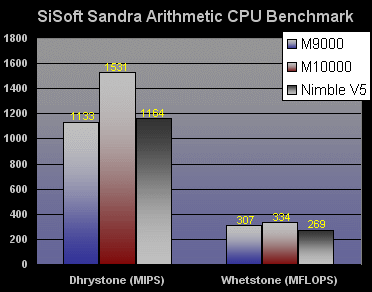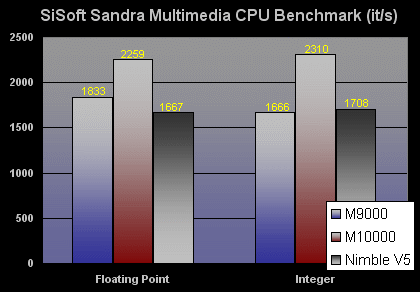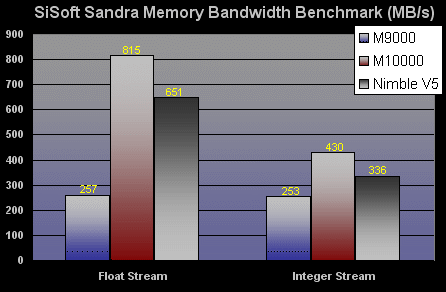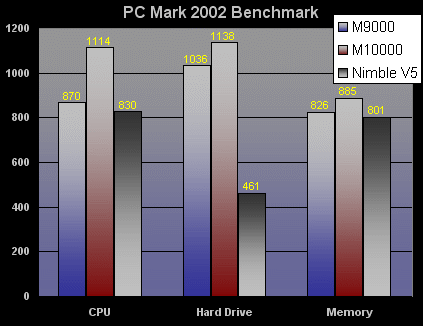|
 Posted: December 18, 2003 Posted: December 18, 2003
Author: Jason Kohrs
Manufacturer: Nimble
Source: Logic Supply
Benchmarking:
Although I realize that the Nimble V5 won’t put up numbers like many are used to seeing from AMD or Intel based systems, a few benchmarks are required to consider any review complete. As a point of reference, the V5 will be tested head to head against a VIA EPIA M10000 Nehemiah (1 GHz cpu) and a VIA EPIA M9000 Ezra (933 MHz cpu), each with 30 GB ATA-66 hard drive and 256 MB of DDR memory. Unlike a modern AMD or Intel system, these two systems should at least provide numbers in the same ballpark as the Nimble V5.
The Nimble V5 will be run through three modules of Sisoft Sandra as well as PCMark 2002, each of which is described in more detail below. In addition to these two benchmarks, I also tried running 3DMark2003, but error messages popped up when the program launched (most likely due to Direct X9 support issues), and I proceeded without it.
Before starting the benchmarks, I put SiSoft Sandra to use to test the thermal properties of the system. I let the “Burn-In Wizard” of SiSoft Sandra run for about 15 loops and then went back and checked the temperatures. The results below startled me, as I am used to seeing the temperatures of my AMD or Intel systems running far below these numbers! The VIA processors can safely run much warmer than other modern CPUs, and the fact that this one hit 72C at full load without any problems confirmed this.

SiSoft Sandra 2003 Professional:
Sisoft's Sandra Max3!, which stands for System ANalyser, Diagnostic and Reporting Assistant, "is an information & diagnostic utility. It should provide most of the information (including undocumented) you need to know about your hardware, software and other devices whether hardware or software." It is a comprehensive program with a suite of thorough benchmarks that is also available in one form as a free download. The three of most interest to me are the CPU Arithmetic Benchmark, the CPU Multimedia Benchmark, and the Memory Bandwidth Benchmark, all of which are charted below.
Test results of the CPU Arithmetic Benchmark are actually charted as two tests; The Dhrystone benchmark and the Whetstone benchmark. Each test analyzes how long the cpu takes to complete a sequence of instructions, and compares these results to reference systems. This benchmark also generates the estimated "Performance Rating" for the system, based on cpu speed, available memory, and other factors.

The results above show that the Nehemiah core found in both the Nimble V5 and the EPIA M10000 provide a serious processing advantage. The Nimble V5 matches up rather nicely with the M9000 Ezra despite giving up 200 MHz in overall speed.
The CPU Multimedia Benchmark is a real-life benchmark that tests the cpu's ability to generate a 860x750 pixel image of a fractal, and compares these results to reference systems. The EPIA M10000 Nehemiah and the Nimble V5’s 733 MHz cpu both utilize Intel's SSE technology for Floating Point support, which is an improvement over the previous EPIA boards that utilize AMD's 3D Now! technology.

The results above show the M10000 Nehemiah with a distinct advantage over the other two systems, but again the Nimble V5 hangs tight with the M9000 Ezra thanks to the advantage mentioned in the previous paragraph.
The Memory Bandwidth Benchmark of SiSoft Sandra reads/writes large chunks of data to memory, with minimal cpu utilization, and reports its results in MB/s.

Once again, the Nimble V5 outshines the M9000 Ezra, but can’t compete with the M10000 Nehemiah.
PCMark2002:
FutureMark's PCMark2002 "is a completely new, multipurpose benchmark, suited for benchmarking all kinds of PCs, from laptops to workstations, as well as across multiple Windows operating systems." Available as a free download, anyone can test their system and use FutureMark's online result browser to see how they stack up with the outside world.

The results in this benchmark are provided as unitless “Marks” and provide a score for CPU, Hard Drive, and Memory performance. The hard drive results are a bit unfair thanks to the two other VIA system employing ATA-133 support with an installed ATA-66 drive. But, as seen in the Sisoft Sandra benchmarks, the Nimble V5 does quite respectably when compared with the M9000 Ezra.
One could obviously run through an exhaustive series of current benchmarks, but all it will really prove is that this machine isn’t intended for the Unreal Tournament fan, or someone who wants to calculate Pi to 100 decimal places quickly!
Please read on to page five for the video conferencing and the conclusion of the Nimble V5... Next
Page 1 | Page 2 | Page 3 | Page 4 | Page 5 | Page 6 | Forum | Review Index
|